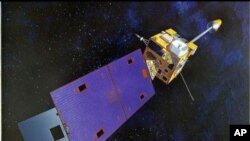Nations of the western hemisphere, especially in South America, will have better warning of dangerous storms, including hurricanes and tropical cyclones, thanks to a newly repositioned United States environmental satellite.
The U.S. Department of the Interior's National Oceanic and Atmospheric Administration or NOAA, recently repositioned its Geostationary Operational Environmental Satellite, or GOES-12 spacecraft from its previous position, at 75 degrees West, to its new orbital location at 60 degrees West. GOES-12 replaced GOES-10, which NOAA first repositioned in 2006 to provide environmental satellite coverage of South America. This coverage will provide forecasters in South America with more imagery and data to track dangerous weather, including storms that can trigger potentially deadly mudslides.
"We're ensuring NOAA satellites are always ready to send the imagery and data that scientists around the world have come to rely on," said Mary Kicza,[KEY-zah] assistant administrator for NOAA's Satellite Information Service. "Shifting GOES-12 speaks to NOAA's serious commitment to protecting lives and property throughout North, Central and South America with continued reliable satellite coverage."
Jack Hayes, director of NOAA's National Weather Service noted that "hurricanes, floods, drought, wildfires and other dangerous weather conditions are not confined to the United States, but affect our neighbors to the south too. We're ensuring meteorologists in South America have timely access to critical data from GOES to help issue accurate, life-saving forecasts."
Moving GOES-12 is a significant contribution to the emerging Global Earth Observing System of Systems or GEOSS.[GEE-oss] This global, public infrastructure allows managers and decision makers to respond more effectively to the many environmental challenges facing societies around the world.
"Argentina views the replacement of GOES-10 by GOES-12 as a clear success for GEOSS in the Americas and a vital source of data for South America,' said Dr. Conrado Varotto, director of Argentina's space agency, CONAE. "The replacement provides timely and adequate data which has allowed the South American countries to respond to meteorological and environmental phenomena in a way that would not be possible if GOES-12 had not replaced GOES-10."
The United States is committed to working with its partners in the Western Hemisphere to understand and predict changes in the environment, including weather that can threaten the lives and damage the property of the people throughout the Americas.
Newly Positioned weather satellite will provide forecasters in South America with more imagery and data to track dangerous weather.
















